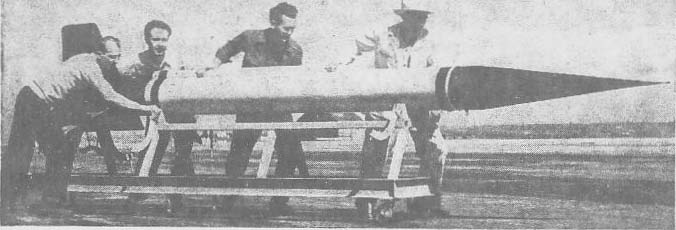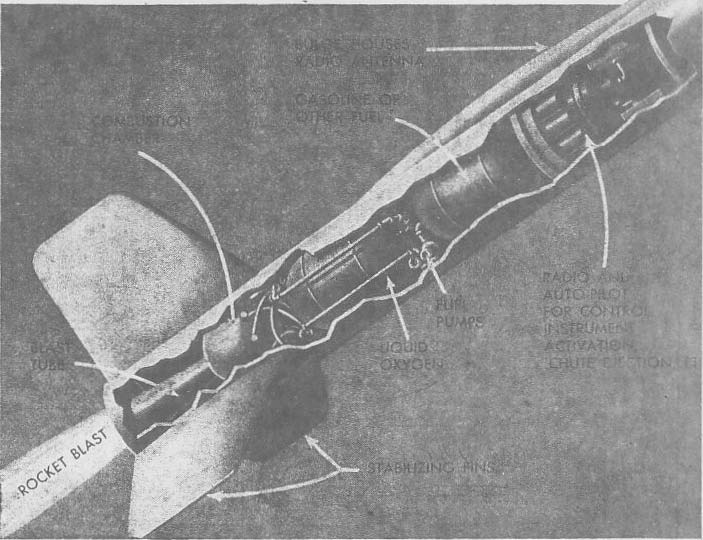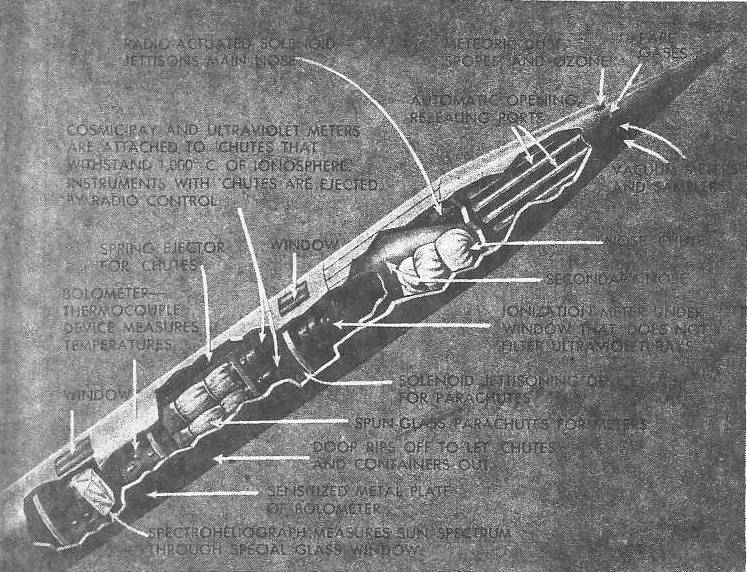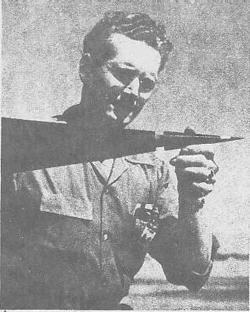IS THE SKY THE LIMITS ?
Ordnance Rockets Demolish the Barriers of Space
Dr. Frank J. Malina
Acting Director, Jet Propulsion Laboratory, California Institute of Technology.
The mind of men have long questioned the physical nature and the behavior of the boundary layer between the earth and the space through which the earth travels on its orbit. "The carry Greeks made the first attempts to describe the atmosphere and to understand the causes of "weather" on the basis of elementary physical measurements. However the inadequate knowledge they possessed forced them to depend primarily on purely philosophical conceptions.

The WAC Corporal ready for loading into the lunching tower.
© Caltech
| |
| |
In this way Aristotle arrived at the conclusion that the atmosphere was divided into three layers. He considered the layer nearest the earth in which life exists as fixed to the earth; the top layer fie believed to be attached to the fiery heavens and to move with them; the region between these two layers fie hypothesized to be extremely cold. Since the Aristotelian view of nature persisted for centuries essentially unchanged, no new interpretations of the atmosphere appeared until the Renaissance, although the Arabs in the eleventh century are credited with estimating from the duration of twilight that the atmosphere extended to a height of fifty-seven miles. A realistic notion of the nature of the earth's envelope began when Torricelli, a student of Galileo, in 1643 constructed the barometer for measuring the pressure of the atmosphere. With this and other instruments the study of the structure of the atmosphere was undertaken up to the heights of mountains. Toward the end of the eighteenth century the balloon vas invented and quickly applied to, extend the upper range of investigation. The sounding balloon has since been developed to a high degree of usefulness; however, the maximum altitude that can be reached under most favorable conditions is about twenty miles. Although men were curious for some rime part to investigate the atmosphere above the limit of balloons, only during the last few years has an urgent need arisen for information at higher levels. It is well known that curiosity alone is seldom considered sufficient justification for the outlay of funds of the magnitude required. The need for this information has been brought about by modern developments in meteorology, radio communication, aviation, long-range guided missiles, and nuclear physics.
The possibility of employing rocket propulsion for lifting a vehicle to great heights was realized at the beginning of this century. Serious consideration of the use of rockers for upper atmosphere research was initiated in this country by R. H. Goddard in about 1914. At first fie studied the feasibility of utilizing the solid-propellant type rocket, but later concluded that a liquid-propellant type would be superior for reaching very high altitudes. He spent many years working on the various problems connected with a sounding rocket, and a great portion of his later efforts was devoted to the development of flight-control equipment. In the early 1930's the subject of rocket propulsion became of interest to various enthusiasts in the United States, with members of the American Rocker Society the must active in pursuing investigations with the funds available. In 1936 a group of research students at the California Institute of Technology became interested in the problem of the sounding rocket, and theoretical and tentative preliminary experiments were carried out until 1939 when work was undertaken for the Army Air Forces on rocket-propulsion systems suitable for the auxiliary propulsion of aircraft. The ideas for a sounding rocket were not implemented until December 1944 when the Ordnance Department requested the Jet Propulsion Laboratory to design and construct a prototype model for the use of the Signal Corps. This model was required to carry 25 pounds of instruments to an altitude of at least 100,000 feet.

Wheeling the WAC to the flight ramp.
© DR
|
A conservative estimate of the factors entering into the design of such a vehicle was made, and it was concluded that the requirements could be met. As development of the vehicle proceeded, material reductions in estimated empty weight were achieved, so that by the time firing tests were initiated at White Sands Proving Ground, N. Mex., in September 1945, the vehicle, known as the "WAC Corporal," reached an altitude of approximately 230,000 feet In order to carry out investigations of the upper atmosphere, it is necessary first to have a vehicle that is capable of reaching the maximum specified altitude; secondly, to develop instruments suitable for making and recording measurements of upper atmosphere phenomena; and, finally, to evolve techniques for recovering the records obtained. Each of these phases poses difficult technical problems, especially the second and third one upon which serious effort is now being concentrated, and about which little can be said in a definite way. Therefore we will limit ourselves in the present discussion primarily to the vehicle phase. The balloon is able to lift itself and a useful pay load because the weight of air displaced by the hydrogen-filled bag is greater than the weight of the vehicle. When the best sounding balloon se far developed reaches an altitude somewhat over 100,000 feet it comes to rest because the displaced rarefied air then equals the weight of the vehicle. Heavier-than-air craft depend on motion through the air for their sustention and at the present time the altitude limit of such craft appears to be in the neighbourhood of 6o,ooo feet. In order to lift a body to altitudes above the balloon limit, it is necessary to apply a propulsive force to the body which will either accelerate it rapidly to very high velocity se that the body will coast to high altitudes, or to accelerate it gradually for a relatively long period of time. Shells from guns have reached heights well over 100,000 feet; however, the acceleration imparted to the shell in the gun barrel is se great that it is practically impossible to design instruments to withstand the firing shock. Jet propulsion furnishes the most promising method for imparting the required velocity to the body with manageable accelerations. Of the various jet-propulsion schemes that have been developed to a high degree of reliability within the last few years, the rocket propulsion system is the most satisfactory for the attainment of extreme altitudes. In a rocket the propulsive force is obtained from the reaction produced by the high-velocity jet composed of a propellant mass carried wholly within the rocket. The force is not affected by the velocity of flight of the rocket, and, since the oxygen in the atmosphere is net utilized for combustion, the rocket will operate even in empty space. As a matter of tact, the rocker is most efficient in absolute vacuum. We might be led to believe from our experience with the familiar skyrocket that the design of a high-performance sounding rocket is not a complex engineering project and that its operation in the field is as simple as lighting a powder fuse. That this belief is erroneous will become clear from the following considerations. Before the button is pushed which starts the rocket on its way to the desired height above the earth's surface, we must resolve these problems: (1) Choice of propellant and type of propulsion system; (2) Size of rocket to carry the desired pay load; (3) Shape of rocket to give minimum air resistance and adequate flight control; (4) Launching method. As one might expect, the separate optimum solutions of these problems will almost certainly clash when an attempt is made to incorporate them into a unified vehicle. 1'o minimize the contradictions that can arise, we need to know something about the relationships between the various problems.

This artist's conception of the WAC Corporal is not necessarily authentic but it indicates graphically the design and possible uses of a sounding rocket. Devices can be incorporated to take samples of the upper atmosphere, to record the strength of cosmic rays, and to broadcast a continuous account of temperature and weather conditions. Equipment and vital parts are recovered by parachute.
© DR
|
These relationships have been well defined as the result of studies made by various investigators on the performance of a vehicle in vertical flight. They will hold as long as the propulsive force is constant during powered flight, and it does not matter if the propulsive force is obtained from the energy of the propellant by a molecular or by a nuclear process. The performance of a sounding rocket is found to be determined primarily by six parameters. The first two, which are descriptive of the propulsive system, are the specific impulse of the propellant utilized and the time the thrust force acts on the vehicle. The "specific impulse" is a descriptive term used to designate the number of pounds' thrust that can be obtained from each pound of propellant each second. The next two parameters, which deal with the weight characteristics of the vehicle, are the ratios of the propellant weight to the initial gross weight and of the initial gross weight to the cross-sectional area of the rocket. The last two parameters are the velocity at which the rocket is launched from the earth and the altitude of the launching point. In addition to these basic parameters the performance of the vehicle will he influenced by the shape of its nose and stabilizing surfaces and the ratio of its length to its diameter. Aerodynamic shapes must be chosen that will produce the minimum of air resistance over the wide speed range traversed during accelerated flight through the atmosphere.

Courtesy Popular Science
© DR
|
Extensive design charts have been prepared to guide the engineering development of a sounding rocket to meet given requirements. We will not be able to consider in this article the detailed implications of the basic parameters; however, a few general conclusions can be pointed out.
At the present time the energy of the rocket propellant must be released by combustion (molecular process). ne highest specific impulse that can now practically be obtained at sea level from a usable solid propellant is about 200 pounds sec./lb. and from a liquid propellant about 240 pounds sec./Ib. The ratio of propellant weight to initial gross weight of the rocket is of extreme importance. A high-performance sounding rocket must have from fifty to eighty per cent of its weight in the form of propellant. This requirement stresses the critical importance of achieving the minimum in weight for the vehicle structure and propulsive system. For example, if the empty weight of the WAC Corporal is reduced by 50 pounds, corresponding to a saving of 18 per cent in structural weight, an increase in altitude of about 60,000 feet can be expected.

Aerial view of quarters and shop aera of White Sands Proving Ground, N. Mex.
© DR
|
In order to minimize air resistance, it is advantageous to have as high a value as possible for the ratio of the initial gross weight to the cross-sectional area of the rocket.
Since only twenty to fifty per cent of the initial gross weight of the rocket is available for structure, propulsive system, and pay load, we can conclude that the required size of the rocket will be primarily determined by the pay load that is to be carried to a given altitude. Let us assume that a rocket weighing initially 1,000 pounds can be designed to carry a pay load of 100 pounds to 500,000 feet; then if we want to increase the pay load to 500 pounds, we can expect the rocket's initial weight to be about 5,000 pounds. Actually, the permissible pay load ratio improves considerably as the size of the rocket increases because, first, the structural efficiency improves and, secondly, the fraction of the thrust lost in overcoming drag decreases. The advantage of a high launching velocity, when obtained by means auxiliary to the vehicle-propulsion system, is evident as is the advantage of launching the vehicle from a high altitude to minimize air resistance. Let us now take a quick glance at some rocket vehicles that have been actually launched. The first serious sustained effort to construct a sounding rocket was carried out by Dr. Goddard. Although the highest altitude reached by one of his rockets was about 7,500 feet when it was launched on May 31, 1935, the rocket is of considerable historical interest. Unfortunately, very meager information was published on the rocket by Goddard before his death in 1945. The Goddard rocket was somewhat over ten feet and the diameter about eight inches. A liquid propellant combination consisting of liquid oxygen and gasoline was used with a motor that delivered about 300 pounds' thrust for a period of approximately 20 seconds. The rocket was launched from a 60-foot tower with an initial velocity of zero. To maintain a vertical flight path, control equipment was provided to operate movable surfaces in the rocket jet. Photographs of the flight show the rocket traveling with an oscillatory yawing motion in the manner of a fish swimming in a vertical direction. High altitudes were first reached by the German V-2 rocket. This vehicle was designed primarily for carrying an explosive charge for the destruction of ground targets. Many of the rockets were launched against England during World War II at a range of about 200 miles, and during the trajectory of the rocket a maximum altitude of approximately 300,000 feet was reached. At the peak of the trajectory the flight speed was about 3,500 feet a second. The German technicians who designed the V-2 state that two of the missiles were maintained in vertical flight after launching and reached an altitude of 560,000 feet. The length of the V-2 rocket is 45 feet, 10 inches; its diameter is 5 feet, 7 inches, and at launching it weighs 28,200 pounds.

Attaching the WAC's needle-sharp nose for piercing shock waves at supersonic speeds.
© DR
| |
The initial gross weight is made up of a propellant load of 19,000 pounds, a pay load of 2,200 pounds, and an empty weight (structure, propulsion system, and control equipment) of 6,900 pounds.
The rocket uses a liquid oxygen alcohol propellant combination from which an average specific impulse of about 223 pounds sec./lb. is obtained during powered flight. The propulsion system delivers a sea-level thrust of about 55,000 pounds for 65 seconds. A predetermined trajectory is maintained by means of an autopilot system which operates vanes both in the air stream and in the rock - et jet. The missile is launched from a vertical position with zero initial velocity. We have sufficient information on the V-2 to evaluate the primary design parameters we considered earlier. We obtain the following values: Average propellant specific impulse…223 Ibs. sec./lb. Thrust (sea level)…55,000 lbs. Thrust duration...65 sec. Ratio of propellant weight to initial gross weight… 0.675 Ratio of initial gross weight to cross sectional area…1,155 Launching velocity... 0 ft./sec. Launching altitude…Sea level In the case of the V-2, the pay load amounts to 7.8 per cent of the initial gross weight. From the point of view of utilizing this rocket for investigations of the upper atmosphere, the amount of pay load that can be carried is more than adequate. The chief limitation of this vehicle is an economic one, for to fire a single round about $75,000 must he expended, and this depends on whether or not the OPA can “hold the line.” Also, in spite of the tact that the V-2 had reached a high stage of development, the Germans found that about thirty per cent of the missile launched failed to perform satisfactorily. We can well imagine the discomfort of the Government budgeteers if they were asked to approve the expressed desire of one scientist to launch 200 sounding rockets simultaneously at various points of the globe, not as a single experiment but to be repeated several times. Fortunately, most measurements of upper-atmosphere phenomena do not require instruments of very great weight, and, furthermore, many scientists feel that during the next decade most studies will be concentrated within the layer up to about 300,000 feet. To meet these requirements, a vehicle of much smaller initial gross weight, and therefore cost, can be employed. The first version of the WAC Corporal reached an altitude of about 230,000 feet. It has an over-all length of 16 feet, a diameter of 1 foot, and an initial gross weight of 696 pounds. A breakdown of this weight is as follows: propellant, 374 pounds; pay load, 25 pounds; structure, propulsive system, and compressed air, 297 pounds. No flight-control equipment is used; instead, the vehicle is launched from a 100-foot tower by means of a booster rocket which gives the vehicle a high initial velocity by the rime the booster thrust is ended at a height of about 150 feet above the launcher. In this mariner the effect of wind is minimized, and the fixed fins of the WAC are able to maintain essentially vertical flight. In the experiments made in New Mexico, one WAC round landed a maximum distance of about seven miles from the launcher when no parachute was used during descent. The WAC is an interesting example of the use of the step-rocket principle which, when utilized to the maximum of its effectiveness, is capable of transporting the final step of a combination to very great heights. For example, if the WAC Corporal were launched as the second step with a V-2 as the mother vehicle, then calculations show that an altitude of approximately 2,000,000 feet would be reached by the WAC Corporal, and at the end of its powered flight it would have a velocity of 9,500 feet a second.
| 








